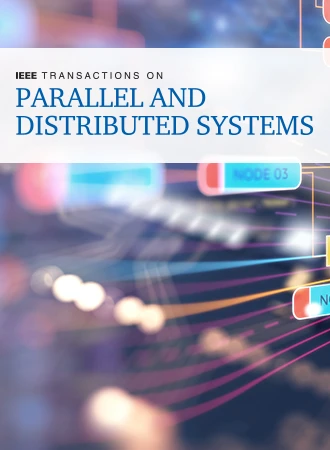高效并行稀疏张量收缩
IF 5.6
2区 计算机科学
Q1 COMPUTER SCIENCE, THEORY & METHODS
IEEE Transactions on Parallel and Distributed Systems
Pub Date : 2025-04-03
DOI:10.1109/TPDS.2025.3557750
引用次数: 0
摘要
我们研究了稀疏张量-稀疏张量乘法(SpGETT)算法的性能。该操作也称为稀疏张量收缩,是稀疏矩阵-稀疏矩阵乘法(SpGEMM)操作的高阶模拟。因此,SpGETT可以通过首先将输入张量转换为矩阵,然后调用SpGETT的高性能变体,最后将生成的矩阵重新转换为张量来执行。或者,我们可以在张量的领域中执行SpGETT基础的标量运算,而不需要矩阵公式。我们讨论了这两种方法中的构建块,并制定了一种基于散列的方法,以避免代价高昂的搜索或重定向操作。我们介绍了当前最先进的基于spgemm的方法、现有的SpGETT方法以及使用本文中提出的一种新的微调散列方法仔细实现的SpGETT方法的性能结果。我们通过将一个张量与自身沿着不同的维度进行缩并来评估在现实世界张量上的方法。我们提出的基于散列的SpGETT方法的性能始终优于最先进的方法,在各种输入实例中平均减少了25%的顺序执行时间,平均减少了21%的并行执行时间。本文章由计算机程序翻译,如有差异,请以英文原文为准。
Efficient Parallel Sparse Tensor Contraction
We investigate the performance of algorithms for sparse tensor-sparse tensor multiplication (SpGETT). This operation, also called sparse tensor contraction, is a higher order analogue of the sparse matrix-sparse matrix multiplication (SpGEMM) operation. Therefore, SpGETT can be performed by first converting the input tensors into matrices, then invoking high performance variants of SpGEMM, and finally reconverting the resultant matrix into a tensor. Alternatively, one can carry out the scalar operations underlying SpGETT in the realm of tensors without matrix formulation. We discuss the building blocks in both approaches and formulate a hashing-based method to avoid costly search or redirection operations. We present performance results with the current state-of-the-art SpGEMM-based approaches, existing SpGETT approaches, and a carefully implemented SpGETT approach with a new fine-tuned hashing method, proposed in this article. We evaluate the methods on real world tensors by contracting a tensor with itself along varying dimensions. Our proposed hashing-based method for SpGETT consistently outperforms the state-of-the-art method, achieving a 25% reduction in sequential execution time on average and a 21% reduction in parallel execution time on average across a variety of input instances.
求助全文
通过发布文献求助,成功后即可免费获取论文全文。
去求助
来源期刊

IEEE Transactions on Parallel and Distributed Systems
工程技术-工程:电子与电气
CiteScore
11.00
自引率
9.40%
发文量
281
审稿时长
5.6 months
期刊介绍:
IEEE Transactions on Parallel and Distributed Systems (TPDS) is published monthly. It publishes a range of papers, comments on previously published papers, and survey articles that deal with the parallel and distributed systems research areas of current importance to our readers. Particular areas of interest include, but are not limited to:
a) Parallel and distributed algorithms, focusing on topics such as: models of computation; numerical, combinatorial, and data-intensive parallel algorithms, scalability of algorithms and data structures for parallel and distributed systems, communication and synchronization protocols, network algorithms, scheduling, and load balancing.
b) Applications of parallel and distributed computing, including computational and data-enabled science and engineering, big data applications, parallel crowd sourcing, large-scale social network analysis, management of big data, cloud and grid computing, scientific and biomedical applications, mobile computing, and cyber-physical systems.
c) Parallel and distributed architectures, including architectures for instruction-level and thread-level parallelism; design, analysis, implementation, fault resilience and performance measurements of multiple-processor systems; multicore processors, heterogeneous many-core systems; petascale and exascale systems designs; novel big data architectures; special purpose architectures, including graphics processors, signal processors, network processors, media accelerators, and other special purpose processors and accelerators; impact of technology on architecture; network and interconnect architectures; parallel I/O and storage systems; architecture of the memory hierarchy; power-efficient and green computing architectures; dependable architectures; and performance modeling and evaluation.
d) Parallel and distributed software, including parallel and multicore programming languages and compilers, runtime systems, operating systems, Internet computing and web services, resource management including green computing, middleware for grids, clouds, and data centers, libraries, performance modeling and evaluation, parallel programming paradigms, and programming environments and tools.
 求助内容:
求助内容: 应助结果提醒方式:
应助结果提醒方式:


